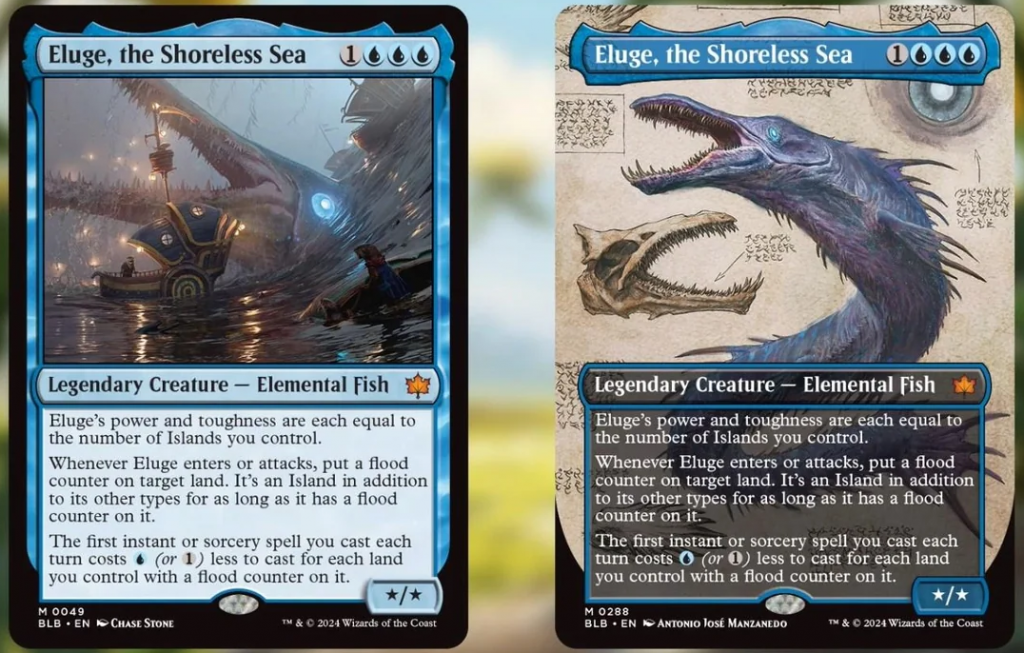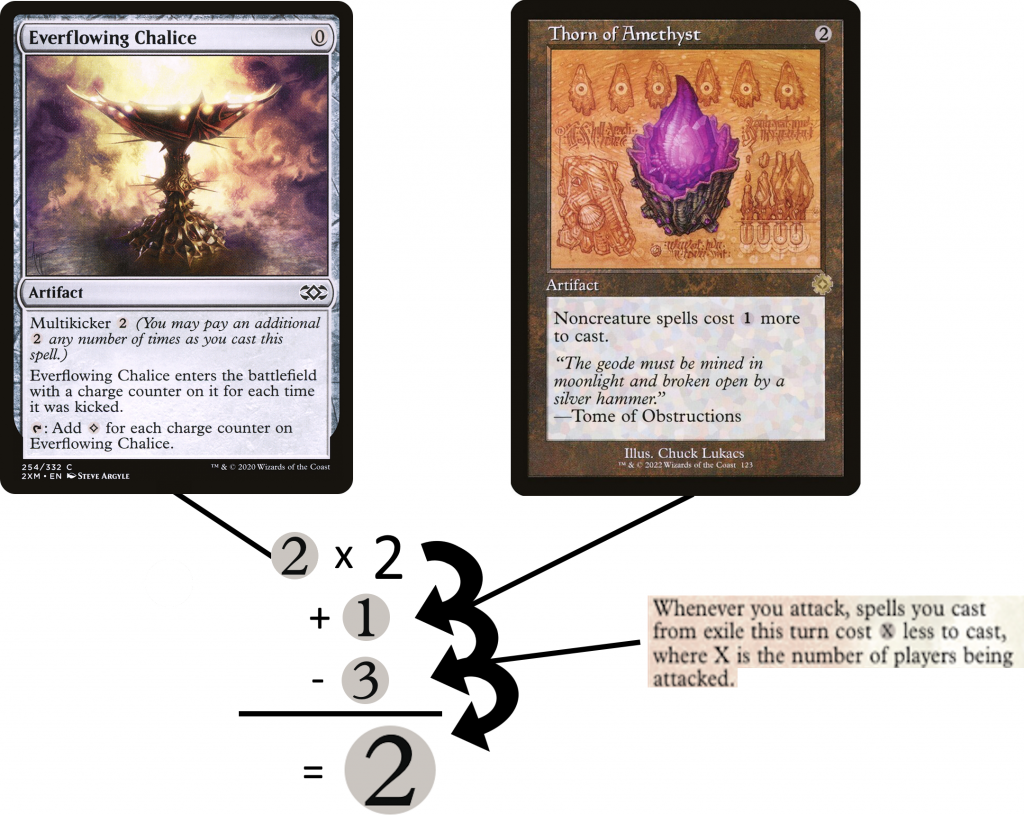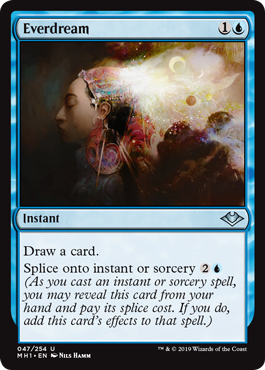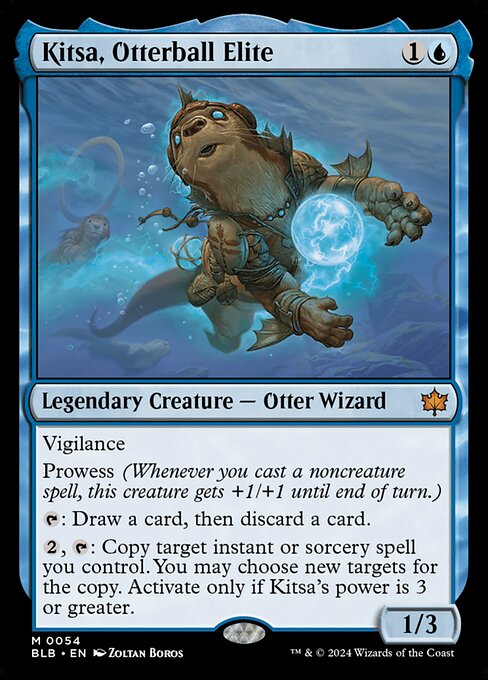One of the single best things you can do in a game of Magic is “Draw a card,” but only slightly less well-known is this: “…spells cost {1} less to cast.” Yes, reducing the overall costs of cards allows savvy players to chain together lines of potent combo pieces together to achieve victory, but largely this path towards a win is stymied by colored mana costs. Until very recently, cost reductions in Magic ‘contributed’ towards either the colored or colorless mana costs of a card, in the case of something like Morophon, the Boundless vs Haughty Djinn. However, in Bloomburrow, a new option for Monoblue has been introduced which breaks this paradigm — and players are beginning to take note.
Allowing you to freely cast spells that otherwise should cost at least some amount of mana is nothing new, but today I wanted to focus on how you can break parity on your own taxes, and layer costs against reductions, in order to stop ‘playing fair.’
Let’s have a chat about CR 601.2f, and Eluge, the Shoreless Sea.

The Rule in Brief
601.2f states the following: “…The total cost is the mana cost or alternative cost (as determined in rule 601.2b), plus all additional costs and cost increases, and minus all cost reductions. If multiple cost reductions apply, the player may apply them in any order…” This means that all additional costs and increases, such as ‘taxes’ provided by something like Thalia, Guardian of Thraben, added costs like Buyback or Kicker, and optional added costs from other cards like Splice or Offspring are tallied first, prior to considering the discount.
Then, a player goes through and reduces the cost by relevant reductions, before the cost becomes “Locked in” (601.2f) and mana is paid if the cost is over {0}. I was personally introduced to this offset when I was looking to build a Red-White Commander, and found Commander Liara Portyr as a potential option. We can look to her in order to see some in-game examples of how this layering comes into effect.
Commander Liara Portyr, until the printing of Doc Aurlock, Grizzled Genius, was mechanically unique due to the following portion of her text: “Whenever you attack, spells you cast from exile this turn cost {X} less to cast, where X is the number of players being attacked.” That was a ‘floating’ reduction, applying to all spells cast from exile until the end of the turn, usually 3 mana worth of discount, sometimes more if extra combats were at play. Until her printing in Commander Legends: Battle for Baldur’s Gate, no other discount to specifically cards cast from exile existed. As an example of why this can be so strong, here’s an example: If I had a Thorn of Amethyst out — one of many cards with an effect like that in the deck — and attempted to cast Everflowing Chalice, kicked twice, the cost would be tabulated as follows.

The above example uses all three ‘flavors’ of cost modification, with taxing, optional increase, and flat decrease, but while Liara certainly allows for some excellent usage of colorless cards (in fact, she’s currently a Boros Eldrazi deck for me), as soon as a colored pip needs to be accounted for, this discount stops being as freely-enabling, and starts showing why mana-generation is still vital to a Red-White gameplan. That said, if you’re casting something like Abrade with a 3 mana discount, an additional {2} worth of taxes still has it ending up costing a single {R}, meaning you’re rewarded for taxing your own cards where they’d otherwise ‘waste’ the max discount. This dance between overpaying and underpaying is part of why tax-based stax decks can be so intriguing, as you thread the needle between hampering yourself too much and leaving opposing game plans stranded in tax season.
A Boundless, Shoreless Sea
This all comes to a head with the printing of Eluge, the Shoreless Sea, one of the Commanders with the subtlest ‘wow’ factor they’ve printed in quite some time. Eluge has some trinket text about its strength scaling with the number of Islands you have, but the meat of its power comes through that final line: “The first instant or sorcery spell you cast each turn costs {U} (or {1}) less to cast for each land you control with a flood counter on it.” It might not seem like it, but much akin to Liara back when she was printed in 2022, this is actually unique text, being the first instance of both colored and colorless mana being discount-able in the same effect. The reason for this effect’s strength should be apparent — Your mind might be racing to freecasting spells like Counterspell, an overloaded Cyclonic Rift, or more, but Eluge does far more than that.
Part of why Eluge is so strong comes down to the way additional costs shake out, as well as alternate casting costs. Suddenly, the turn Eluge hits the board, you can cast Wash Away and counter a Commander, or hold it until you have 3 flooded lands, and Cleave it to counter any spell. With those same 3 flooded lands, you can pay a mere {3} instead of {4}{U}{U} to cast Capsize with Buyback, or bounce a 0-2 mana permanent with Repeal without paying mana. However, these are surface-level advantages, and while Eluge simply does what Monoblue does well better than nearly any other Commander, the finer details are where the fish thrives.

Everdream & Wincon
I’d like to showcase this using Everdream, an uncommon from Modern Horizons 2, which fails to show up on Eluge’s EDHREC page, despite being perhaps the single-best card the deck can play. Everdream is a simple card, being a Think Twice at face-value, with the text “Splice onto instant or sorcery {2}{U}”. Splice is one of the original truly parasitic mechanics, and because of that its intricacies tend not to be common knowledge. Referring back to the rules, “702.46a. Splice onto [subtype] [cost] means “You may reveal this card from your hand as you cast a [subtype] spell. If you do, copy this card’s text box onto that spell and pay [cost] as an additional cost to cast that spell.” Paying a card’s splice cost follows the rules for paying additional costs in rules 601.2b and 601.2f-h.” As we can see, Splice simply follows the rules for additional costs, and as we’ve discussed, those are added before reductions.
To showcase the strength of that in Eluge, let’s look at how this interacts with things like cheap counterspells, and Delve cards. If you cast a Strix Serenade with 3 flooded lands, Eluge is making that spell free, which is obviously fantastic, but much like in our Liara example, you’re ‘wasting’ that extra discount; if you Splice Everdream onto Serenade, however, suddenly the spell costs {U}, but it’s drawing you a card, and retaining Everdream in hand (as Splice merely reveals it, so it never leaves, nor goes away if the Spliced-onto card is countered). As your flooded lands ramp up, Everdream becomes more and more accessible, with spells usually either being entirely free, or with an extra draw, something Eluge does not provide itself. With Delve, similarly, Splicing Everdream onto a Dig Through Time changes its effective mana cost to {8}{U}{U}{U}, but with 3 flooded lands and 8 cards in the graveyard to exile, that’s a free DTT that draws a card on top of everything else.

It also helps that Everdream is very accessible, as both something you can tutor for with the Transmute ability on Muddle the Mixture, and Spellseeker, among more generic tutors. As is generally true, if your wincon and value engines have similar tutor-ability, that flexibility allows you to be active at all stages of the game. To that end, we’re also running a combo which requires 2 different mana value 2 spells, arguably the best Monoblue combo in Commander now, following the release of Bloomburrow. This combo is headlined by Narset’s Reversal, already a decent card in Eluge, plus either Isochron Scepter or Kitsa, Otterball Elite, as well as any Extra Turn spell (and something to occasionally turn it on). It goes as follows: With a live Kitsa/Scepter imprinted with Narset’s Reversal, you cast your Extra Turn spell (first, so you discount it with Eluge), holding priority. Next, you either simply bounce and copy it with the Sceptered Reversal, or with Kitsa, cast Reversal from your hand. If done correctly, you allowed the Prowess triggers on Kitsa to resolve after each step, now turning on her second activated ability, allowing you to copy the cast Narset’s Reversal, targeting itself. The copied Reversal returns the original reversal, copying it, with the 2nd copy targeting the Extra Turn spell, returning it to hand as well. While convoluted, this achieves effectively infinite turns, from which you can combo off with other pieces, or simply swing in with Eluge over and over.
Critically, the above combo is highly tutor-able (Artifacts, Wizards [via Wizardcycling], and Instants are all accessible), and every piece is individually already good in Eluge. Playing no bad cards as part of a combo, in a control deck already strapped for advantage, is fantastic. Instead of providing card advantage, Eluge instead gives players ‘action advantage’, the ability to simply play out more cards over more turns than other players. While you can freely cast counterspells to your heart’s content, however, you often run out of cards, which is where things like Everdream, Archmage Emeritus, or Wavebreak Hippocamp come in. That said, Eluge already wants the game to go long, as you only get your discount once per turn (or, better yet, four times per turn cycle), so you’d be perfectly fine killing players with commander damage after locking the game up behind interaction.
Variations on Eluge

Part of why Eluge has become so fascinating to myself and so many other players, being a mere three decks away from being a Top 10 Monoblue Commander on EDHREC, is because he simply does Blue…well, Blue-er. It’s honestly rather difficult to build a version of Eluge, at any budget, which is truly unsalvageable. Whether you’re playing {X} spells and cloning Eluge, using every ounce of Kamigawa’s spite and playing Arcane/Splice, or pushing the fish to the fringes of cEDH, the floor on this Commander is shockingly high. That said, the difference between a fully-tuned Eluge deck and one that’s merely ‘fine’ is miniscule relative to many other Commanders, but in my eyes that comes down primarily to knowing what sort of meta you’ll be playing in, and when your power spikes occur.
I refer to 1/3/5 and 2/4/6 when talking to folks about building their own Eluge deck, which I do with shocking regularity on the 200+ person Eluge Discord. These refer to the number of flooded lands required in order to cast different types of spells at certain junctures; every Eluge deck will have a combination of all of these spell amounts, but how you’re thinking about these costs greatly impact the pace of play, and potential fragility.
1/3/5 Eluge decks focus on a variety of conditional interaction, such as Swan Song, Mystical Dispute, and Wash Away, with Eluge’s discount turning on a ton of your interaction suite the moment he hits the board. At 3 flooded lands, you can generally cast your 5 mana spells while holding up interaction, and at 5 flooded lands, your best Extra Turn spells are free, making combos far easier. This version of the deck is aiming to come out swinging, and is primed to be the table policeman in faster metas. An ideal sequence for 1/3/5 is casting Eluge on turn 2/3, spending the first turn cycle with available interaction, and on your first turn untapping with Eluge, slamming an Extra Turn spell to catapult you up to the next rung of discounts.
2/4/6 Eluge is greedier, with a much higher ceiling; you rely on having either Essence Flux, Aquitect’s Will, or Splash Portal in your opening hand, in order to blink Eluge or otherwise flood an additional land the first turn he comes down, passing with 2 flooded lands. This allows you to play free Mana Drains and Cyber Conversions, more universal interaction that doesn’t require an opportune moment, as well as clones on your first untap with Eluge like Irenicus’s Vile Duplication to double-up on discounts. This version aims to cast huge draw spells, massive instants, but falters when you’re not able to hit that initial bonus flooded land. If you’re playing in a slower, grindier playgroup, this might be the way to go.
Personally, I play a build closer to the paradigm set by 1/3/5, with as many interactive pieces which also draw as possible, given Eluge makes it rather easy to churn through cards without finding some sort of value engine. Repeal, Remand, and Pulse of the Grid stand out as ways to recoup advantage while still being a player with the capability to stop opposing problem cards.
Example Decklist: You Snooze, Eluge
This article is only really touching the surface of why Eluge is just a damn cool Commander, but really, what makes it tick comes down simply to truly bringing back permission control as a strategy. When I began my journey in Magic, my first Commander was Barrin, Master Wizard, and from then on I got hooked on Mono-blue. Interacting, drawing, simply being the boogeyman to combo players — it’s honestly a rush when folks look to you with fleeting hope that their Voja will resolve. In a cEDH context, Eluge is the first commander in a long time that enables this sort of game plan, as Baral, Chief of Compliance has long since been power crept out as the don of permission control from the late 2010s.
Eluge also enables you to do some wicked things with lands, some that I’ve actually not yet touched-upon. You can see in the above list the inclusion of cards like Saprazzan Skerry, Hall of the Bandit Lord, and Boseijiu, Who Shelters All — each of these wears a flood counter beautifully, as tapping them like an Island avoids the life cost, and opportunity to potentially be sacrificed in the case of Skerry. You can even play lands which don’t natively tap for mana, like Maze of Ith or Tabernacle at Pendrell Vale (the latter of which will surely brand you as a That Guy at most tables), removing the downside of these lands’ inability to produce mana.
If you want more flooded lands, there’s opportunities in cards like the aforementioned Aquitect’s Will, but also The Flood of Mars and honorary-flooder Aven Courier, but these cards are just a bit off for the speed at which I want Eluge to play. While having extra Flood Counters via blinking Eluge is good, generally Eluge comes down while you have ~3 lands anyway, meaning once you blink him twice or otherwise place 2 more counters, you’ve hit your max; this can be offset by cards like Mitotic Manipulation or Retraced Image putting additional Islands into play, but you greatly need to decrease your number of utility lands for this to function. In this list, there’s also one of a few ‘trap’ inclusions, being Quicksilver Fountain. While flooding lands for free seems wonderful, the eventuality of removing them 100% strikes this from being worth a slot, as if it ever empties your flooded lands, you’re a fish out of water. Ojer Pakpatiq, Deepest Epoch is another card I often see in lists which really doesn’t make sense; while Rebound on blue instants is great, with how Rebound works it often eats up your Eluge discount without actually needing to, a similar issue with Quantum Misalignment. Engulf the Shore also always bounces Eluge, a huge blind spot if done at an inopportune time, so I recommend board wipes like Consuming Tide or Season of Weaving, which allow you to always have an Eluge onboard, and often accrue additional value!
To Fish, with Love

I could go on about Eluge forever — it truly is the first Commander since Baldur’s Gate to get my blood pumping, and mind brewing. It helps that the art’s fantastic, and there’s a shocking number of Eluge merch options available, finally giving me a worthwhile Magic-themed shirt to wear at FNM. Further still, the fact that Eluge is a Fish (a gar, specifically), as opposed to a Serpent or Kraken tugs at my heart strings, as my college thesis hinged on palaeoichthyology, quite literally the study of placoderms in the late Silurian. A Monoblue Fish Commander that gets to play table cop feels like it was made for me, but thankfully, Eluge has attracted a great number of players across the power spectrum! As mentioned, it’s nearly a Top 10 Monoblue Commander on EDHREC, and the Eluge-specific Discord has over 200 members, on top of the Fish seeing curious control pilots peck at its potential for cEDH in an era of midrange. You can quite literally do anything with Eluge in Blue, and likely see some form of results.
In terms of actually playing Eluge, you may notice a trend depending on the power level of the table — the weaker the overall power is, the more Eluge will be targeted for interruption. Eluge can be a scary card for those not playing a ton of mana acceleration or free cards, and those tables also tend to have more removal in general, meaning Dive Down or Shore Up might be just what you need against trigger-happy upgraded precons. Inversely, at higher power tables, Eluge is less of an immediate threat, as you need to in-theory ramp up to your combo and free casting, which means a tuned 1/3/5 Eluge build can sneak in as a permission control piece that stymies combo decks, or even begins to outrace midrange once parity of card advantage is reached. You need to know as soon as you sit down with your opponents whether you’ll be perceived as the threat, and act accordingly; often, if you can be the ‘bad guy who stops worse guys’ by preventing combos or overflowing value, you’ll be evaluated favorably, meaning you can safely flood your lands until it’s far too late to put the fish on ice.
I hope you were able to learn something from this deep dive into the Shoreless Sea, and cost manipulation as a whole! While not the flashiest Commander, I feel that Eluge is going to continue to rise in popularity as more folks hear about him, and frankly, I’m doing my part to spread the word. There isn’t a better Blue Spellslinger option at the moment, and being a permission control messiah only heightens this appeal. I wouldn’t be surprised if you begin to see the fish at your local game store, online, or in a (hopefully) well-kept aquarium; my list is still being iterated-upon, and I’m meeting new people almost every day with ideas about how to best play Eluge, which is simply the best feeling. If you have any ideas for further Commander Focuses, or just want to show off a sweet Eluge brew, let us know in the comments below!
Until next time, just keep swimming.
Have any questions or feedback? Drop us a note in the comments below or email us at contact@goonhammer.com. Want articles like this linked in your inbox every Monday morning? Sign up for our newsletter. And don’t forget that you can support us on Patreon for backer rewards like early video content, Administratum access, an ad-free experience on our website and more.


